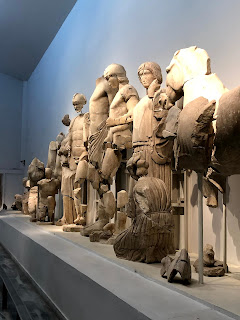 |
| Arkoudi - clearly more of a summer place |
We had taken several days to cover the short distance to Olympia from the ferry crossing to Patras. We don't need to be in Kalamata to pick up our post until Friday, and wanted to wait for the forecast storms to clear. Our first stop was the pretty resort of Arkoudi. A wander around the shuttered up streets revealed there was almost no one in occupation, apart from an American woman feeding the many cats, and a German couple with a motorhome, but staying with an old friend. After a short chat we headed to the beach to see how much sand Elsa could collect in her coat playing ball. The answer appeared to be most of the beach, so we were grateful for the external shower point we'd had fitted.
The next morning we moved to nearby Kastro to explore Castle Chlemoutsi, the vast Frankish crusader fortress built in 1220. It's the biggest of its kind in the Peloponnese, and the walls are still largely intact. The throne room was huge and must have been daunting for visitors, the small museum had been beautifully curated, and the list of former owners included some familiar names from the Angevin dynasty, before it was taken over by the Ottomans. We were only slightly embarrassed that our arrival meant that the stewards sheltering in the ticket office had to grab umbrellas and rush to take their places inside the castle. Fortunately two other visitors arrived while we were there.
 |
| A castle built to last |
 |
| We have seen a lot of rainbows though |
Unsurprisingly we slept in. When we at last emerged the rain had eased. We went for a walk around the port, spotting a yacht with a familiar name: Christina O. Only one of the most famous yachts in the world, a former Canadian destroyer converted by Aristotle Onassis into a luxury yacht which was to host everyone from JFK to Elizabeth Taylor. She's now for sale, but you can charter her for half a million dollars a week - off-season.
 |
| The Christina O in port |
 |
| 3rd century BCE robot |
 |
| How the temples were built |
We threw back the curtains the next morning to sunshine and blue skies, and quickly drove down to the town where we found a river to walk along with the spaniels. Then it was straight over to the museum and the archaeological site. Delphi had been impressive, but the top deity there was Apollo. One of the dodecatheon - the top twelve gods - certainly, but Olympia was dedicated to Zeus. No-one was higher in the pecking order than Zeus, and Olympia makes that clear.
 |
| The return of blue skies |
 |
| The Eastern pediment |
 |
| Detail from the Western pediment |
 |
| The Western pediment |
The excavations at Olympia cover a wide area, and we wandered around, stopping at the Temple of Hera where the Olympic flame is lit, and the stadium, where the ancient games were held. Sadly we saw a couple of stray dogs at the site being rounded up by dog-catchers. They were handled kindly, but with so many stray dogs in Greece it's hard to be optimistic about their future. The young man who ran the restaurant where we stopped for lunch with Max and Elsa seemed surprised they were picking up the dogs, and kept a close eye on the two "attached" to their restaurant. They may be strays, but they would obviously be missed.
 |
| Site of the Olympic Games - 2500 years ago |
A warm day, and a relaxing lunch left us little inclined to squeeze in a visit to the museum of the Olympic Games before 3pm closing, so we have returned to the open air theatre for the night and will go back to Olympia tomorrow.
 |
| Where they light the flame |


It makes me very happy that you have that 7 year old memory Neri. 💖
ReplyDeleteThat storm sounds a little like the one we experienced while parked on the Downs in Bristol on Sat night. I was also expecting Scamper to be blown over and felt positively elated in the morning that we were upright and safely in bed. 😃
The picture of the Olympic Games 2500 years ago was not what I was expecting, it could have been somewhere in England. 😉 Not far now until you’re Christmas stop over. X